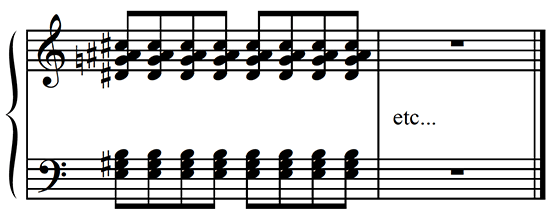A Saxophonist’s Guide to the Concept of Polytonality
 This article is a lesson that comes to us courtesy of world-renown saxophonist, Jon Gordon, and also appears in his book, Foundations for Improvisors.
This article is a lesson that comes to us courtesy of world-renown saxophonist, Jon Gordon, and also appears in his book, Foundations for Improvisors.
For this lesson it’s essential that you have or can get access to a keyboard to play through and hear this material.
One concept I find very helpful to musicians is the role of the various triads that you’ll find in different scales. For example, G and A major triads in G Maj7+11, F major and G minor in G-7 or G-11, and Bb and E major triads in F diminished. But if we extract two or more of these triads and play them simultaneously we are by definition creating polytonality. This is a famous example of polytonality from Stravinsky’s “Rite of Spring”

It’s D#7/E Maj7, built straight up in 3rds. You’ll notice however, that the only note that differs from E Maj7+11 is the G natural, which we’d call a +9. So the chord could also be written as E Major7 #9 #11. (By the way, you’ll notice that a plus sign, +, and a sharp sign, #, mean the same thing when describing chord alterations.) You can find scales that work over polytonal chords (G# Harm. minor over D#7/E) but also try to deal with the individual tonalities as well. If you see Bb/E triad the B or F diminished scale is clearly an option, but how about:

At the start I’m just thinking of outlining the two different tonalities. I think the F# (natural 2nd) leading to the E triad makes you hear that tonality more so than if it wasn’t there, same with the C to Bb in the 1st bar. By the end of bar 2 I’m thinking the B diminished scale more.
Also, I often like to stack chords as in the above quote of Stravinsky. Take any two tonalities a major 7th apart and go straight up in 3rds.

One particular example of this that I like over D- and/or G7, is to outline E/F. Over G7 I also like Eb/E, or even Eb/E/F. If you analyze this you see that F over G7 is obviously a tonal option. The E triad adds a G# which is the flat 9 above G. And we know that we can use the E triad via the Ab diminished scale. The Eb triad includes a #9 and a flat 13, and these notes would be found in G7 altered dominant (Ab melodic minor). To me this is like using, or being able to use, any or all harmonic possibilities at any time, or even simultaneously.

You’ll notice that in this stacking technique used above that I outlined triads. This is a very simple and clear way to outline a tonality. However, as you become more comfortable with this kind of thinking you can use other kinds of shapes and lines that outline or suggest one or more tonalities less obviously.
Write out lines over the following chords. A/F ( this denotes a major triad over just the bass note), A/F Major ( both major triads), F#-/G-, and E-/F-/Ab. With some of these polychords you may find a common scale that works, for ex., for A triad/F you could easily use D melodic minor. But you could also use D harmonic minor, the A augmented scale, or create your own scale that comprises notes from both the A major scale and F major or minor, even though F is shown as just the bass note. If you’re writing it you can interpret it as you like, and maybe find some very interesting sounds to incorporate into your playing and writing.
Build 8 more polytonal sounds or polychords and write lines over each of them. In your own writing and arranging, as well your playing over tunes, look for places where you can use these sounds musically, without just plugging them in for the sake of using them. The hippest sound is not always the most complex. Also remember that the note below the slash can signify either a bass note or chord. If you see a letter without a chord quality below a slash it usually indicates just a bass note. If composers and arrangers want it to be a triad or chord they’ll usually indicate that as I did above.
Lastly, along with the suggestions above, sit at a piano and experiment with playing and creating various polytonal sounds. For example, slowly play an F# major scale in your right hand while playing some kind of D- in your left (try harmonic minor, then melodic, etc.) Then switch and play F# major in your left hand and D- in your right. Try other scale combinations. Be aware of all the various harmonic possibilities you may be implying with the 2 simultaneous scale tones. I suggest that you focus on this material for about 3 weeks.
Be a part of Jon Gordon’s new Artishshare project! You can pre-buy the CD, or become a producer level supporter of the recording. There are also offers designed specifically to bring students into the process of the creation of the CD. Click here to check out the project!
http://www.artistshare.com/Projects/Experience/64/506
http://www.artistshare.com/projects/Index/64/195
http://www.jongordonmusic.com





